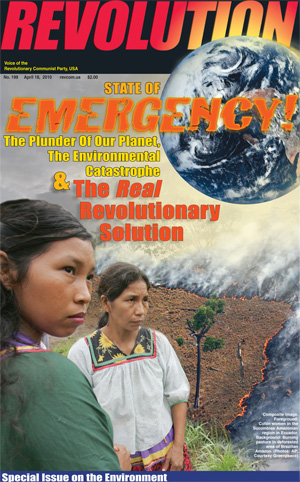Global Inequalities and the Climate Crisis: A Chart
| revcom.us
Climate change is posing an unprecedented threat to the existence of humanity, and of other forms of life, on this planet. It’s a global danger. The prime cause of this looming catastrophe is the system of capitalism-imperialism—its “expand-or-die” growth driven by the competitive quest for profit and global dominance—a system that relies on fossil fuels and relentless resource extraction. This is a system characterized by a big divide in the world between the rich “developed” countries and the poor “undeveloped” countries, between the haves and have-nots, the oppressors and the oppressed. This is the greatest inequality in the world today.
This chart shows some of how the glaring global inequalities that result from this great chasm are made worse and deadlier by the climate crisis, and how those inequalities have affected climate change.
Basic Facts:
Impact on Oppressed Countries:
Links for Sources and Further Info:
Basic Facts: The U.S. and other wealthy countries are the main cause of the global climate crisis and have emitted far greater amounts of carbon dioxide (CO2)—the main greenhouse gas driving global warming—than poor countries have.
Impact on Oppressed Countries: From the industrial revolution until now, the capitalist-imperialist U.S. and European countries have established and enforced a reckless, profit-driven path of development reliant on fossil fuels across the globe which has now endangered the very existence of humanity. They have also been directly responsible for 52% of all CO2 emissions. The U.S. alone has accounted for 25%. The poorest half of the world’s population—3.5 billion people—is responsible for just 10 percent of carbon emissions. In the words of climate scientist James Hansen, the U.S. “is, by far, more responsible than any other nation” for global warming.
Links for Sources and Further Info: Climate Change in a Nutshell: The Gathering Storm, James Hansen, 12/18/18; “World’s richest 10% produce half of carbon emissions while poorest 3.5 billion account for just a tenth,” Oxfam, 12/2/15

The U.S. is more responsible than any other country for global warming. This coal-fired plant in Georgia is one of the country’s top CO2 emitters, releasing 27.2 million tons in 2007 alone.
Basic Facts: None of the capitalist industrial powers of the world are on track to meet the goals of the 2016 Paris UN climate agreement.
Impact on Oppressed Countries: The Paris accord’s goals for limiting CO2 and other gases that trap heat in the atmosphere were totally inadequate to actually deal with the climate crisis, but three years on, no major power is meeting even them. The only two countries which are—Morocco and Gambia—are among the poorest countries in the world, with the least responsibility for global warming. The U.S., under Trump, has declared its intention to withdraw from the Paris agreement, and has rolled back many minimal restrictions on carbon emissions. Meanwhile, global carbon emissions have increased every year since 2016, as the planet burns.
Links for Sources and Further Info: Climate change report card, National Geographic, 9/19/19; The UN Paris Agreement was 3 years ago; here's how countries are doing with their climate goals, GOOD magazine, 9/20/19
“Not fit caretakers of the earth” – clip from Revolution: Why It's Necessary, Why It's Possible, What It's All About, a film of a talk by Bob Avakian given in 2003.
Basic Facts: Global warming is contributing to water crises in poor countries by radically reshaping long-term weather and rain patterns
Impact on Oppressed Countries: Northern countries are expected to receive more rainfall, while many subtropical arid and semi-arid regions will get less. This means less surface and groundwater for drinking and irrigation, which will hit oppressed nations the hardest. As early as 2020, as many as 250 million Africans could face water shortages as a result of climate change. By the 2050s, the number of people facing water shortages in Asia could hit 1 billion. Already in India, 200,000 people die each year from lack of water or from contaminated water. Fourteen of the world’s 20 biggest cities, most in the Third World, are currently experiencing water scarcity or drought.
Links for Sources and Further Info: “The Nations That Will Be Hardest Hit by Water Shortages by 2040,” VICE.com, Aug. 26, 2015; “Climate change will hit poor countries hardest, study shows,” Guardian, Sept. 27, 2013; UN Framework Convention on Climate Change, “Climate Change: Impacts, Vulnerabilities and Adaption in Developing Countries,” New York, 2007, p. 3; David Wallace-Wells, The Uninhabitable Earth – Life After Warming (Tim Duggan Books 2019), pp. 88, 261, 267
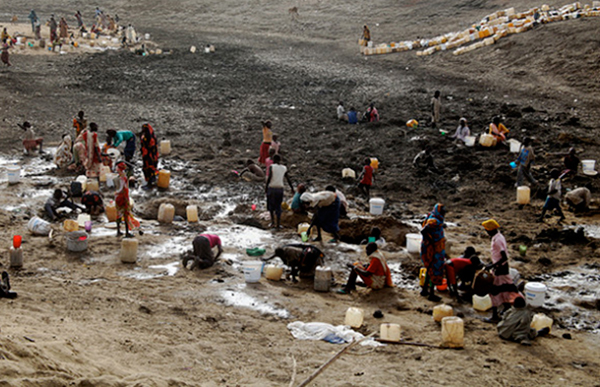 People dig for water from a dried-up watering hole in South Sudan, which suffers from extreme water scarcity. Photo: Jared Ferrie/IPS news.
People dig for water from a dried-up watering hole in South Sudan, which suffers from extreme water scarcity. Photo: Jared Ferrie/IPS news.
Basic Facts: Global warming is causing sea levels to rise.
Impact on Oppressed Countries: Rising global temperatures are causing the massive ice sheets covering Greenland, Antarctica, and the Arctic as well as glaciers around the world to melt. This is leading to rising sea levels, which will have devastating consequences for many poorer Third World countries. In 2017, floods in South Asia killed 1,200 people, leaving two-thirds of Bangladesh underwater and affecting 41 million people. Climate scientists predict that by 2050, rising sea levels will permanently submerge some 20 percent of what is today Bangladesh and displace about 20 million people.
Links for Sources and Further Info: “Sea Level Rise will Disproportionately Affect Developing Countries,” Earth.org, 12/12/18; David Wallace-Wells, The Uninhabitable Earth – Life After Warming (Tim Duggan Books 2019), p. 63; Natural Resources Defense Council, “Bangladesh: A Country Underwater, a Culture on the Move,” 9/13/18
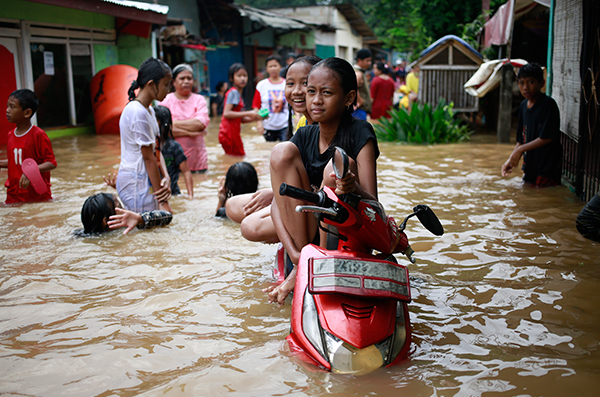 Coastal flooding, due in part to rising sea levels driven by global warming, is already having devastating consequences, especially in Asia and the Pacific. Jakarta, Indonesia, 2017. Photo: AP
Coastal flooding, due in part to rising sea levels driven by global warming, is already having devastating consequences, especially in Asia and the Pacific. Jakarta, Indonesia, 2017. Photo: AP
Basic Facts: Global warming is increasing the frequency and intensity of extreme weather, and those in poorer countries are suffering most.
Impact on Oppressed Countries: During the past 50 years, some 69 percent of deaths from extreme weather-related events—such as droughts, wildfires, floods, landslides, heat waves and large storms—have taken place in poorer countries. Since 2000, this death rate in poor countries has been seven times higher than in wealthier countries.
Links for Sources and Further Info: “Time to redress the globally unjust cost of climate change,” International Institute for Environment and Development, Sept. 2019
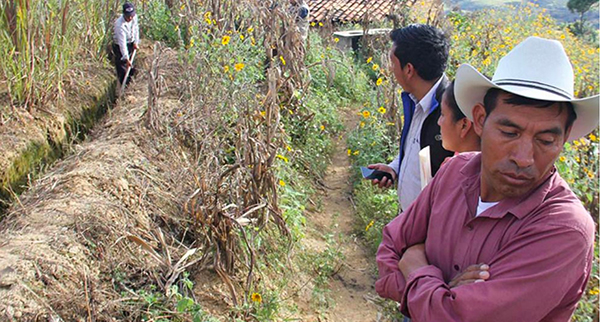 In 2018, drought-related crop failures affected one in 10 Guatemalans, causing extreme food shortages for almost 840,000 people. Droughts and hunger have been a major factor driving Guatemalans and other Central Americans to migrate north. Here Guatemalan farmers examine their crop. Photo: FAO
In 2018, drought-related crop failures affected one in 10 Guatemalans, causing extreme food shortages for almost 840,000 people. Droughts and hunger have been a major factor driving Guatemalans and other Central Americans to migrate north. Here Guatemalan farmers examine their crop. Photo: FAO
Basic Facts: Climate change is fueling massive displacement and migration due to droughts, food shortages, rising seas and extreme weather.
Impact on Oppressed Countries: In the world today, there are nearly 70 million refugees forced from their homes. Of that figure, about one-third, or 23 million people, was displaced by extreme weather events that are becoming more common and destructive because of global warming. The number of Central American migrants forced to flee their countries, due in large part to climate change, increased five-fold between 2010 and 2015. These were unusually dry years, leaving many without enough food. By 2050, there may be 143 million more “climate refugees” from the Third World regions of Latin America, sub-Saharan Africa, and Southeast Asia.
Links for Sources and Further Info: The climate crisis, migration, and refugees, Brookings Institution, 7/25/19; Groundswell: Preparing for Internal Climate Migration, World Bank, August 2018; Central American Farmers Head to the U.S., Fleeing Climate Change, NY Times, April 13, 2019; “Climate Change Threatens the World’s Food Supply, United Nations Warns,” New York Times, 8/8/19

Basic Facts: Climate change is worsening the threat to global food supplies.
Impact on Oppressed Countries: The global food supply is being threatened by capitalism’s relentless, profit-driven exploitation and consumption of land and water resources and by climate change.
Extreme weather and rising temperatures are contributing to turning more and more fertile land into desert, accelerating land degradation and soil loss and hurting global food supplies.
More than 500 million people now live in areas that are turning into deserts, and soil is being lost at a rate 10 to 100 times faster than it is forming. Scientists predict declining crop yields and massive food shortages that will likely hit poor countries far harder and sooner than richer ones.
Fishing communities in the tropics and Arctic are already being severely impacted by the loss or shifting of marine and coastal ecosystems. By 2020, in some African countries yields from rain-fed agriculture could be cut in half. A 2˚ Centigrade rise in global temperatures from the pre-industrial era would put over half the continent’s people at risk of undernourishment.
Links for Sources and Further Info: “Climate Change Threatens the World’s Food Supply, United Nations Warns,” New York Times, 8/8/19; “Climate Change Is Regressive,” Center for Global Development, 4/1/14; “Responding to climate change,” United Nations Environment Programme
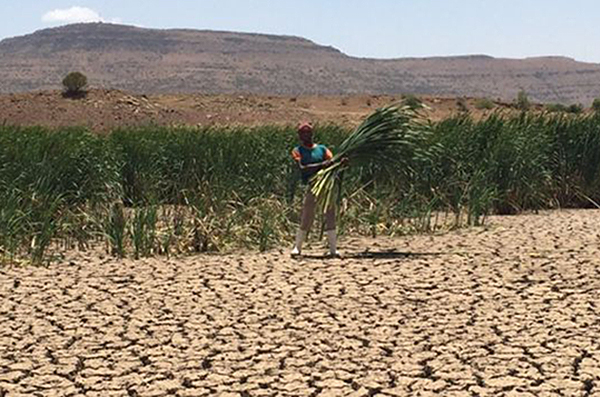
Rising temperatures are turning increasing areas of fertile land into desert. South Africa, 2017. Photo: BBC
Basic Facts: Biodiversity loss is now happening 1,000 times faster than it normally does naturally, because of human activity and climate change.
Impact on Oppressed Countries: People in oppressed countries are most dependent on biodiversity (the variety of plant and animal life and microorganisms) for clean air and water and food supplies because they’re more directly tied to agriculture and the natural world for their survival. Yet they are now suffering the greatest biodiversity loss. The warm tropical regions of the world, historically rich in biodiversity, are being hit hardest, with the devastating Amazon fires this year a heart-rending example. Vertebrate species (for example, amphibians, fishes, birds, and mammals) populations declined by 89 percent between 1970 and 2014 in Latin America and the Caribbean, 64 percent in the Indo-Pacific region, and 56 percent in Sub-Saharan Africa, compared to 21 percent in North America.
Links for Sources and Further Info: “Biodiversity loss is a development issue,” International Institute for Environment and Development, April 2019
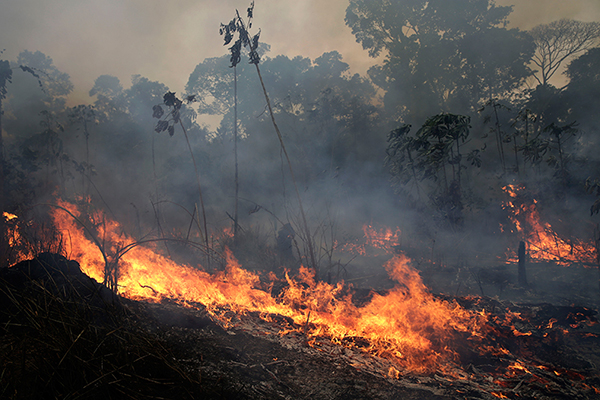
One of the 40 destructive fires in Brazil’s Amazon rainforest in August 2019. Photo: AP
Basic Facts: New climate-driven dangers from disease—threatening people in poorer countries the most
Impact on Oppressed Countries: People around the world, especially in poorer countries, will face grave new dangers in a warmer and, in some areas, wetter planet. According to the World Health Organization, contagious diseases are increasing due to “the combined impacts of rapid demographic, environmental, social, technological and other changes in our ways-of-living. Climate change will also affect infectious disease occurrence.”
Serious diseases like cholera, Ebola, and Lyme disease will likely spread as global warming causes more massive rainfall, flooding, and other extreme weather events. Mosquitoes will move beyond their current habitats, carrying diseases such as malaria—first impacting broader swaths of the poorer countries with fewer health resources, where these diseases are concentrated today. Yellow fever used to be largely confined to remote areas of Brazil’s Amazon basin. But by 2017, because of climate change, mosquitos that spread the yellow fever virus had reached São Paulo and Rio de Janeiro, and now 30 million people who live in those cities face a disease that kills between 3 and 8 percent of those infected.
Links for Sources and Further Info: “Climate change and human health - risks and responses,” World Health Organization, 2019; “How does climate change affect disease?“ Stanford EARTH, 3/5/19; “How Climate Change Is Exacerbating the Spread of Disease,” Columbia University, 9/4/14; David Wallace-Wells, The Uninhabitable Earth—Life After Warming (Tim Duggan Books 2019), p. 109
Read the special issue of Revolution: State of EMERGENCY! The Plunder of Our Planet, The Environmental Catastrophe & The Real Revolutionary Solution which goes deeply into many of the issues discussed in this article, and what is to be done about it.
Download pamphlet (PDF) here
Basic Facts: Global inequality is being worsened by climate change.
Impact on Oppressed Countries: In 2015, poorer, oppressed countries were forced to bear 78 percent of the cost of climate change, a figure which will rise to 87 percent by 2035 according to estimates. “The gap between the economic output of the world’s richest and poorest countries is 25 percent larger today than it would have been without global warming,” according to a recent Stanford report.
Links for Sources and Further Info: “Climate Change,” Center for Global Development; “Climate change has worsened global economic inequality,” Stanford EARTH, 4/22/19

Get a free email subscription to revcom.us:


